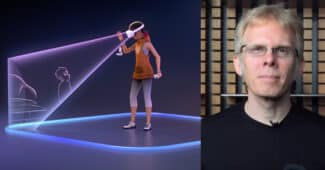The newest episode of Meta CTO Andrew Bosworth’s podcast reveals a range of technical and strategic insights from VR expert and independent AI researcher John Carmack.
Carmack formally left Meta in December to focus on developing Artificial General Intelligence after a decade-long run helping shape the direction of VR development at Oculus and advising executives at Facebook. Carmack still tends to refer to himself as part of the effort, with Bosworth joking in the podcast that he’s a “permanent member” of the team. No matter the formal definition, Carmack seems to be making a habit of advising Bosworth on Meta’s shortcomings in VR even if he’s no longer being paid to do so.
The entire podcast is worth a listen as it covers new ground from previous published discussions between Carmack and Bosworth. There’s more detail on the decision to shut down Echo VR as well as a balanced look at how the main features of Star Trek’s Holodeck — the ability to speak to the computer and have it render a world around you fine-tuned to your commands — are perhaps achievable in technology’s furthest foreseeable future. There’s even a breakdown of exactly what Neural Radiance Fields could offer VR. You can find the Boz To The Future podcast on Apple and Spotify.
Near the end of the podcast Bosworth asks Carmack a few questions starting with the following: “Your vision for Quest hardware has always been light, cheap and fast. If you had to pick one vector to push on for future VR hardware, what would it be?”
Carmack declines to reduce his answer to just one vector of improvement and then outlines his suggested path for Meta’s next steps in VR focusing on reduced friction. Here’s a lightly edited transcript of the two-minute segment with highlights bolded:
If the VR experience – about how tedious it was to start, or how much glitchiness there was there, or the limited availability of the things you wanted to do – if that was on your phone… What would your phone be like if you had to set up and acknowledge guardian every time that you started it up? If you had to wait for your controllers to wake up before you could start doing inputs there? So getting to that point, not just light and cheap, but it should also be instant. You should just be able to like pull it up and put it on your head to just glance over there to look at something as easily as you would look at your watch.
I think that level of feedback and the lack of latency is critically important, but then it needs to just be able to actually do all of the things that people want to do. I keep saying how VR needs to displace all of these other devices. For the early adopters, the people that are at that bleeding edge – they buy everything. You get a VR headset in addition to your second, third, fourth TV and your tablet and your Chromebook and all of these things. But to get to the whole world it needs to replace those things. It needs to go ahead and say, well, if you buy the VR headset, you don’t need to buy this Chromebook. You can just attach a keyboard to it. You don’t need to buy this extra TV, you’ve got your big screen theater there. You don’t need this tablet, this is gonna be able to run the Android apps directly there. And the super frustrating thing is like all of that’s just right there for us. It’s just a matter of doing it… We just need to go do it. The programmers just need to do this instead of that. So I’m still very bullish on it’s going to happen, that the value of head mounted displays is extremely large.
They can be cheaper than cell phones in some ways. They can have all of these abilities while providing the big screen value. They can have the unique advantage of virtual reality with the spatial movement and the hand tracking and the things that we’re doing with that while subsuming all of these other things, I still think it’s a great bet, and it’s Meta’s to lose at this point.





